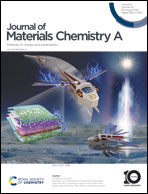High open-circuit voltage in lead sulfide quantum dot solar cells via solution-phase ligand exchange with low electron affinity cadmium halides†
Abstract
The deployment of colloidal quantum dots (QDs) in building high-performance solar cells and other optoelectronic applications relies on the passivation of unsaturated surface atoms through ligand engineering to attain a trap-free energy bandgap and strong QD coupling while maintaining the quantum confinement effect. Despite major advancements in surface passivation strategies, the open circuit voltage (Voc) of lead sulfide (PbS) QD solar cells is limited by undesirable sub-bandgap states and high-bandtail states. The most advanced solution-phase ligand exchange strategy for PbS QDs depends on lead halide ligands, which improved the photocurrent and fill factor in QD solar cells significantly, but only an incremental change in Voc is observed. Here we showcase a solution-phase hybrid ligand passivation strategy for PbS QDs using shallow electron affinity cadmium halide and thiol ligands. The cadmium halide ligand treatment results in the sub-monolayer substitution of surface Pb atoms by Cd atoms. The photophysical properties of QDs improve significantly to show intense band edge emission, diminished trap emission and reduced Urbach tail states. The photovoltaic devices built using cadmium halide-treated QDs show low reverse saturation current, which helps to attain a record 0.7 V Voc (for a 1.28 eV bandgap) and 12.3% PCE.

- This article is part of the themed collection: #MyFirstJMCA


 Please wait while we load your content...
Please wait while we load your content...